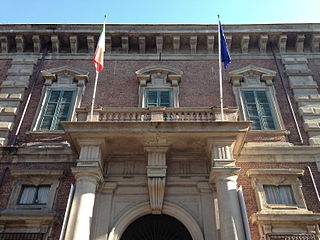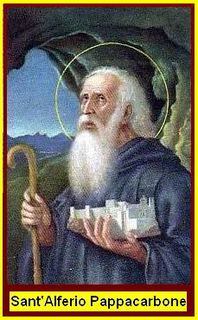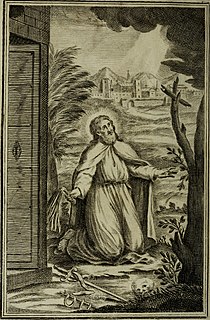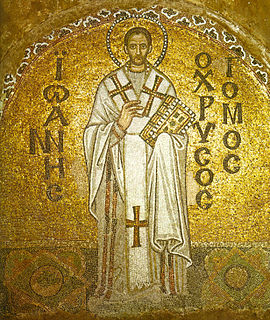Biography
Bonazzi was the second of six children of Count Nicola, lord of San Nicandro and Adelaide Sorrentino of the lords of Pomigliano. At the age of seven he was admitted to the Benedictine abbey of La Trinità della Cava in Cava de' Tirreni and on 6 November 1849 he became part of the cloistered community there. He studied at the school of the Santissima Trinità of Cava de' Tirreni and was named as a novice of Montacassino on 15 August 1859.

La Trinità della Cava, commonly known as Badia di Cava, is a Benedictine territorial abbey located near Cava de' Tirreni, in the province of Salerno, southern Italy. It stands in a gorge of the Finestre Hills.

Cava de’ Tirreni is a city and comune in the region of Campania, Italy, in the province of Salerno, 10 kilometres northwest of the town of Salerno. It lies in a richly cultivated valley surrounded by wooded hills, and is a popular tourist resort.
Bonazzi specialised in the study of Ancient Greek and Latin. On 19 December 1863 he was ordained at Naples by Bishop Tommaso Michele Salzano. He graduated from his studies on 12 December 1865 at the University of Naples. As a philosopher, orator and writer he was member of several academies and cultural associations.

The Ancient Greek language includes the forms of Greek used in Ancient Greece and the ancient world from around the 9th century BCE to the 6th century CE. It is often roughly divided into the Archaic period, Classical period, and Hellenistic period. It is antedated in the second millennium BCE by Mycenaean Greek and succeeded by medieval Greek.

Latin is a classical language belonging to the Italic branch of the Indo-European languages. The Latin alphabet is derived from the Etruscan and Greek alphabets, and ultimately from the Phoenician alphabet.

Naples is the regional capital of Campania and the third-largest municipality in Italy after Rome and Milan. In 2017, around 967,069 people lived within the city's administrative limits while its province-level municipality has a population of 3,115,320 residents. Its continuously built-up metropolitan area is the second or third largest metropolitan area in Italy and one of the most densely populated cities in Europe.
On 27 November 1872 Bonazzi was named professor of the University of Naples, but he refused the position, preferring the school of Badia cavense, which he put in charge of in 1878, as its prefect. Bonazzi's principle interest was pedagogy. He sought to reform the system of Greek teaching in schools. He was the author of numerous scholarly texts, which inspired new methods of teaching. One of his works was commended by the 7th Italian Pedagogical congress. His most important work, which received acclaim across Europe, remains the Dizionario greco-italiano, which was in print from 1880 to 1927 with twenty-five editions, by the publishers, Morano di Napoli.
Simultaneously, Bonazzi's ecclesiastical career continued. In 1892 he became Vicar general of the diocese of Badia Cavense. At the death of the abbot Michele Morcaldi, on 7 March 1894, Pope Leo XIII appointed him abbot of the Cavense monastery. Subsequently, at the death of cardinal Donato Maria Dell'Olio, archbishop of Benevento, Leo XIII consecrated him as the replacement, on 9 June 1902. On 11 June he was ordained at the Basilica of Saint Paul Outside the Walls and he took possession of the archdiocese of Benevento on 24 August.
A vicar general is the principal deputy of the bishop of a diocese for the exercise of administrative authority and possesses the title of local ordinary. As vicar of the bishop, the vicar general exercises the bishop's ordinary executive power over the entire diocese and, thus, is the highest official in a diocese or other particular church after the diocesan bishop or his equivalent in canon law. The title normally occurs only in Western Christian churches, such as the Latin Church of the Catholic Church and the Anglican Communion. Among the Eastern churches, the Mar Thoma Syrian Church of Kerala uses this title and remains an exception. The title for the equivalent officer in the Eastern churches is syncellus and protosyncellus.

Pope Leo XIII was head of the Catholic Church from 20 February 1878 to his death. He was the oldest pope, and had the third-longest confirmed pontificate, behind that of Pius IX and John Paul II.
Donato Maria Dell'Olio was an Italian cardinal and Catholic archbishop.
After around thirteen years of episcopal government and a final Lenten sermon, Bonazzi fell ill and died during the vigil for his elevation to the rank of cardinal, which Pope Benedict XV had ordained for him. He was buried in the church of St Clementina at Benevento.
Lent is a solemnity religious observance in the Catholic liturgical calendar that begins on Ash Wednesday and ends approximately six weeks later, before Easter Sunday. The purpose of Lent is the preparation of the believer for Easter through prayer, doing penance, repentance of sins, almsgiving, and denial of ego. This event is observed in the Anglican, Eastern Orthodox, Oriental Orthodox, Lutheran, Methodist, and Catholic Churches. Some Anabaptist and evangelical churches also observe the Lenten season.

Pope Benedict XV, born Giacomo Paolo Giovanni Battista della Chiesa, was head of the Catholic Church from 3 September 1914 until his death in 1922. His pontificate was largely overshadowed by World War I and its political, social, and humanitarian consequences in Europe.
This page is based on this
Wikipedia article Text is available under the
CC BY-SA 4.0 license; additional terms may apply.
Images, videos and audio are available under their respective licenses.

Pope Benedict IV was Pope from 1 February 900 to his death in 903. The tenth-century historian Flodoard, who nicknamed him "the Great", commended his noble birth and public generosity. He succeeded Pope John IX (898–900) and was followed by Pope Leo V (903).

The Accademia di Belle Arti di Brera, also known as the Accademia di Brera or Brera Academy, is a state-run tertiary public academy of fine arts in Milan, Italy. It shares its history, and its main building, with the Pinacoteca di Brera, Milan's main public museum for art. In 2010 an agreement was signed to move the accademia to a former military barracks, the Caserma Magenta in via Mascheroni, but the move had not happened by early 2017.

Saint Peter of Pappacarbone was an Italian abbot, bishop, and saint. He was abbot of La Trinità della Cava, located at Cava de' Tirreni. Born in Salerno, he had first been a monk at Cava under Leo I of Cava. He then was at Cluny from 1062 to 1068 and later became bishop of Policastro in 1079.

Saint Alferius (930–1050) was an Italian abbot and saint. After spending many years as a layman in civil service, in 1002 he was named the head of a delegation from his city to speak with King Henry II of France. Taking ill during the journey, he convalesced at a monastery and vowed to become a monk himself if he recovered. When he did, he became a Benedictine. He subsequently founded the monastery of La Trinità della Cava, located at Cava de' Tirreni.

The Diocese of Chiavari is a Roman Catholic ecclesiastical territory in Liguria, northern Italy. It was created on 3 December 1892 by Pope Leo XIII in the Bull Romani Pontifices. It is a suffragan of the Archdiocese of Genoa.
The Diocese of Cava was a Roman Catholic diocesis located in the Italian region Campania. It existed from 1394 to 1986, and was informally known as Cava and Sarno from 27 June 1818 to 25 September 1972 while in union with the neighboring Diocese of Sarno.
Domenico Carafa della Spina di Traetto was a Catholic Cardinal, Archbishop of Benevento and Camerlengo of the Sacred College of Cardinals.
Francesco Maria Gerard Vito was an Italian economist and university rector.
Nunziante Ippolito (Nunciante) was an Italian physician and anatomist. He studied in Naples and worked in one of the most important hospitals of the Reign of Two Sicilies and Europe, the Ospedale degli Incurabili. He worked also at Pellegrini hospital and at the University of Naples. Ippolito died in 1851.

Leo I of Cava was an Italian abbot and saint. He is remembered as the second abbot of the Abbey of La Trinità della Cava, located at Cava de' Tirreni and is revered as a saint by the Catholic Church.

The Accademia Pontaniana was the first academy in the modern sense, as a learned society for scholars and humanists and guided by a formal statute. Patronized by Alfonso V of Aragon, it was founded by the poet Antonio Beccadelli in Naples during the revival of classical learning and later led by Giovanni Pontano who gave it a more official character to the meetings.
The Annales Cavenses are a chronicle compiled at the La Trinità della Cava abbey in Cava de' Tirreni, province of Salerno, southern Italy.
It consists of annalistic entries spanning the years 568 to 1318, i.e. essentially the entire duration of the Middle Ages in Italy.

Ottone Frangipane, also known as Saint Ottone, was a Benedictine monk and a hermit. In Italian Roman Catholic theology he is patron saint of Ariano Irpino and the diocese of Ariano Irpino-Lacedonia.

The Biblioteca statale del Monumento Nazionale Badia di Cava or the State Library of the National Monument of the Abbey of Cava de' Tirreni, is a national library whose collection originated with works from the Benedictine abbey of La Trinità della Cava, located on Via Michele Morcaldi #6, Cava de' Tirreni, province of Salerno, region of Campania, Italy.
The ecclesiastical region Campania is one of the sixteen ecclesiastical regions of the Catholic Church in Italy. It consists of three ecclesiastical provinces, twenty-two dioceses, one territorial prelature, and two territorial abbeys. Its territory roughly corresponds with the Italian Republic homonymous region's one.
Michele de Bologna, C.R. (1647–1731) was a Roman Catholic prelate who served as Archbishop of Amalfi (1701–1731) and Bishop of Isernia (1690–1698).

Vito Carmelo Colamonico was an Italian geographer, geologist and scholar. Perhaps he's best known for his studies on some karst dolines and landforms of Italy, most notably Pulo di Altamura, Pulicchio di Gravina and Gurio Lamanna.



















